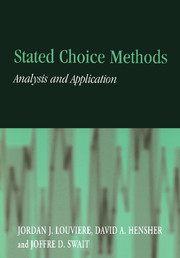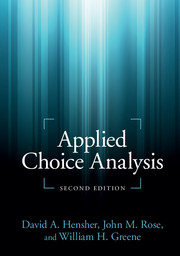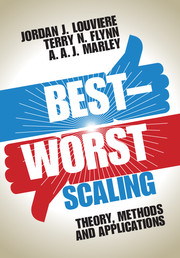Stated Choice Methods
Understanding and predicting the behaviour of decision makers when choosing among discrete goods has been one of the most fruitful areas of applied research over the last thirty years. An understanding of individual consumer behaviour can lead to significant changes in product or service design, pricing strategy, distribution channel and communication strategy selection, as well as public welfare analysis. This graduate and practitioner guide, first published in 2000, deals with the study and prediction of consumer choice behaviour, concentrating on stated preference (SP) methods - placing decision makers in controlled experiments that yield hypothetical choices - rather than revealed preferences (RP) - actual choices in the market. It shows how SP methods can be implemented, from experimental design to econometric modelling, and suggests how to combine RP and SP data to get the best from each type. The book also presents an update of econometric approaches to choice modelling.
- Guide to significant method of analyzing consumer choice
- Explains hoe to design experiments and model results, and how to combine stated choice and revealed choice approaches
- Has applications for business, strategic planning and public economics
Reviews & endorsements
' … recommended to anyone interested in stated choice models, for example graduate students in search of an interesting thesis project or advanced researchers tackling a policy problem. … also a valuable source for those wishing to update their knowledge of econometric choice modelling and analysts working in the applied policy evaluation profession.' Journal of Applied Econometrics
Product details
September 2000Paperback
9780521788304
420 pages
241 × 170 × 23 mm
0.68kg
110 tables
Available
Table of Contents
- 1. Choosing as a way of life
- Appendix A1. Choosing a residential telecommunications bundle
- 2. Introduction to stated preference models and methods
- 3. Choosing a choice model
- Appendix A3. Maximum likelihood estimation technique
- Appendix B3. Linear probability and generalised least squares models
- 4. Experimental design
- 5. Design of choice experiments
- Appendix A5. 6. Relaxing the IID assumption-introducing variants of the MNL model
- Appendix A6. Detailed characterisation of the nested logit model
- Appendix B6. Advanced discrete choice methods
- 7. Complex, non-IID multiple choice designs
- 8. Combining sources of preference data
- 9. Implementing SP choice behaviour projects
- 10. Marketing case studies
- 11. Transportation case studies
- 12. Environmental valuation case studies
- 13. Cross and external validity of SP models.





